This was published 8 months ago
Left to rot: The ‘ghost homes’ scourge in our big cities – amid a housing crisis
In the thick of a housing crunch, tens of thousands of homes in Sydney and Melbourne sit empty and dilapidated, often deliberately so. Meanwhile, well-loved apartment buildings are being razed to make way for luxury blocks with far fewer units in them. Where’s the political and social outrage?
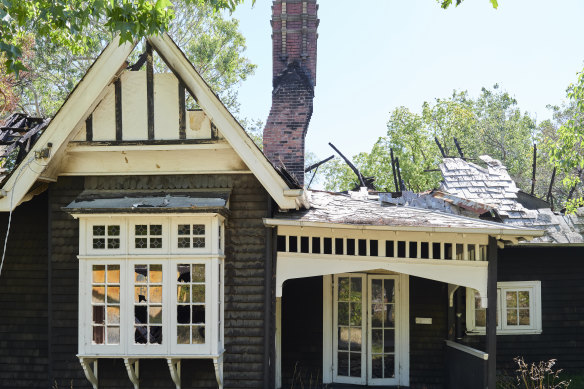
Shenley Croft, in Melbourne’s Canterbury, was almost destroyed by a mysterious fire last December.Credit: Peter Tarasiuk
Angry flames burst through the slate roof as if ignited by a grenade, soaring high into the night sky, shrouding the fairytale house in a hellfire orange haze. The glare of the fast-moving inferno, which erupted at 2am, lit up the faces of the 30 firefighters frantically trying to quench the flames and stop the embers from reaching neighbouring houses. Mercifully, no one was inside Shenley Croft, at 7 Mangarra Road in Melbourne’s Canterbury on that still, sultry night last December: the heritage-listed home had been empty and left to rot since it was sold to a property investor four years earlier.
As dawn broke, the full scale of the destruction became apparent: smoke hissing out of sections of collapsed timber flooring littered with scorched redwood shingles; the surviving rafters above a blackened skeleton. The telltale signs of a blaze deliberately lit – traces of flammable liquid – led police to section off the house with the blue-and-white tape of a crime scene. Locals reported seeing a white ute parked outside in the hours before the fire.
When she received news of the fire, Tarni James, whose father, Bob, had bought the house back in 1957 and whose mum, Merle, lived there until her mid-90s, burst into tears. All she could do when she arrived at her childhood home was stare into the “lonely and silent” charred remains, breathing in the smoky air, overcome with memories: the noisy family dinners, her mum teaching dance in the airy back studio, the theme parties her parents threw for neighbours and their kids. One comfort: the essential structure had survived. “Some of the external walls were still intact, including the facade,” recalls James, a former TV producer. “My old attic bedroom and parts of the roof were gone, but it struck me: yes, it could be rebuilt.”
James and her three siblings had reluctantly put the house on the market after their mother went into care. It sold in December 2019 for $3.1 million, then was quickly on-sold to a property speculator, Wang Hua, who is chairman of the Chinese retail and real estate conglomerate, Jeshing Group. Shenley Croft is now listed under the name of one of his relatives, Zhennan Wang. (Good Weekend is not suggesting Wang Hua or Zhennan Wang had anything to do with the fire.)
Wang Hua has, over the past decade, bought a string of high-end properties across Melbourne, among them the landmark Toorak mansion, Idylwilde, which he bought with his then-wife, Xiao “Kylie” Yan Bao, in 2013 for $18.5 million. Idylwilde, in one of Melbourne’s most prestigious streets, was demolished two years later – to the outrage of nearby residents – after the local council reversed an earlier non-demolition order, deeming on appeal that the home didn’t offer sufficient architectural significance. The site, which Xiao Yan Bao sold in 2015, is still empty. Wang Hua, who splits his time between China and Australia, also bought the former Cancer Council building in Rathdowne Street, Carlton, in 2013 for $20.6 million. Located in a World Heritage-listed precinct near the Royal Exhibition Building, it has since fallen into dilapidation, leading up-in-arms locals to describe it as an eyesore.
If selling Shenley Croft was a sorrowful moment for Tarni James, watching it languish for the next four years was even more distressing. “I drove past in the months after the sale and saw doors left wide open, allowing vandals to come in and steal light fittings and brass handles,” she recalls. “There was zero maintenance over the years, with roof slates falling off, and water damage to ceilings and walls.”
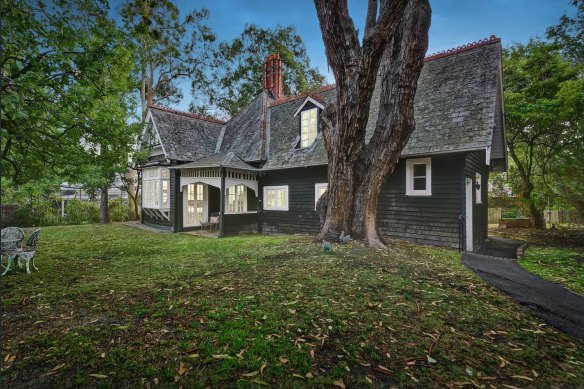
Melbourne heritage home Shenley Croft before the fire.
Repeated neighbour complaints to the council about the fast-deteriorating house fell on deaf ears. If heritage-protected Shenley Croft, classified as a fine example of Edwardian architecture in the Queen Anne style, could meet this fate, what hope is there for other listed houses, let alone unlisted ones? Nearly half the Edwardian double-brick homes in Mangarra Road, once known as “Canterbury’s Golden Mile”, have been bulldozed over the past 15 years, replaced not by higher-density dwellings but by single brick-veneer McMansions, many in a faux-French style, with far fewer trees. At 49 Mangarra Road, an 1890s jewel of pink-hued bricks and white filigree verandahs was demolished more than two years ago within months of failing to get heritage protection. It remains an empty block, as does what was, until recently, another Edwardian home. Yep, demolished.
That Shenley Croft was left unoccupied for four years before the fire lays bare a growing phenomenon: homes sitting empty in many of Melbourne and Sydney’s most sought-after areas. Not just grand, heritage-listed dwellings like Shenley Croft either, but garden-variety bungalows, semis and terraces built during the 19th and 20th centuries: the homes many of our parents, grandparents and great-grandparents built and lived in. When Shenley Croft went up in flames it made the news, as did the suspicious blaze in 2022 at a $24 million historic mansion in Northwood, on Sydney’s lower north shore, owned by fund manager Ouyang “Owen” Chen. His developer friend, Steve Nassif, along with another man, recently pleaded guilty to damaging a property by fire (there’s no suggestion of wrongdoing by Chen). But there are also untold thousands of average, unoccupied old homes that we don’t hear about, left to decay and fall victim to bulldozers.
A new analysis by the think tank Prosper Australia based on water use – a reliable indicator of occupancy – identified 97,861 vacant or underused properties in the Melbourne metropolitan area in 2023, equivalent to one in 20 dwellings. The fastest growth in unoccupied properties has occurred in the City of Melbourne, where 10,000 homes are currently empty. “This is why vacant properties are such an important problem,” says Catherine Cashmore, president of Prosper Australia. “Supply is not just about building new houses.” In Sydney, meanwhile, analysis of electricity consumption from the 2021 Census showed hundreds of empty homes across the eastern suburbs and lower north shore alone.
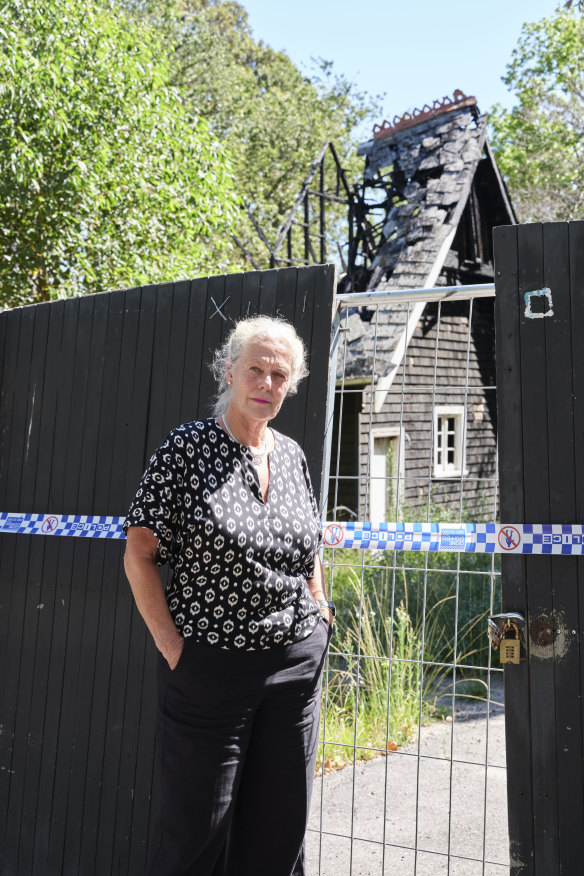
Tarni James stands in front of the charred remains of Shenley Croft, her childhood home.Credit: Peter Tarasiuk
The staggering number of empty homes in Melbourne and Sydney poses a moral question at a time of record home prices and a brutal housing crunch, yet it’s rarely mentioned by the Property Council of Australia, the peak group representing builders and developers, or the YIMBYs – Yes-in-My-Backyarders – who argue that greater density and increased supply are needed to reduce house prices. Prosper has been crunching the data on unoccupied properties since 2007, when its former director of advocacy, Karl Fitzgerald, noticed umpteen empty houses and blocks of land on his bike-ride to work in Melbourne at a time when headlines were all about record low land supply. Stories about vacancies inevitably focused on the number of advertised rental vacancies, a separate issue from unoccupied properties.
Houses can sit empty for myriad reasons. In coastal towns, for example, they’re frequently holiday homes, unoccupied for most of the year or under-occupied because they’re being rented out through Airbnb. In inner-city areas, too, a significant number are boltholes or secondary residences, inactive for much of the year. There are cases where an owner may have inherited a house but doesn’t want to sell or lease it out, either because they lack the funds to bring it up to rental standard, or they fear being unable to evict tenants. But a common contributor, especially among properties left empty for years or decades, is “speculative vacancy”. This occurs when a developer or speculator plays the long game of “land banking” dwellings for future capital gain, which may involve allowing an older house to fall into fatal decay to provide a convincing case to council for demolition and maximum redevelopment. “It makes practical and economic sense to encourage these speculative vacancies onto the market to address the supply concerns we have now,” says Cashmore.
But in a speech to the National Press Club in March, the chief executive of the Property Council of Australia, Mike Zorbas, dismissed the prevalence of land banking, insisting “a quick look under the hood shows this is an evidence-free zone”. Cashmore isn’t buying it. “The developers themselves report on their land banks in their annual reports,” she scoffs. “It’s laughable to suggest this practice isn’t rampant across the industry.”
When capital gains is the overriding aim – let a house sit there and see it rise in value – tenants can sometimes be regarded as more of a liability than asset, bringing as they do human issues and associated costs (requests to fix the mould or the hot-water system and so on). Tax breaks take on a whole new meaning when they apply across property portfolios, too, making it cost-efficient to leave some properties empty while others are full. “There are many reasons why properties can be left vacant, but the bottom line is that investors are primarily interested in the capital gains from land inflation,” says Cashmore. This is particularly so, she adds, when an investor owns a property outright and doesn’t have to service a loan.
Developers complain about projects that would help fix the housing crisis being held up by a thicket of council rules, zoning regulations and heritage controls. YIMBY Melbourne has taken aim at Boroondara Council in the eastern suburbs, where Shenley Croft is located, as the local government area (LGA) with the greatest capacity for higher density, suggesting it should have the largest annual target for new homes – 4900. It also wants to “upzone” the existing two- and three-storey height limits across much of Boroondara, which takes in the older suburbs of Ashburton, Balwyn, Balwyn North, Camberwell, Hawthorn, Hawthorn East, Kew, Kew East, parts of Glen Iris, Surrey Hills and Canterbury. It was claimed in a widely publicised report released in April that nearly a third of the LGA is subject to heritage controls (Boroondara Council says the figure is 21.6 per cent, with a fair chunk of that taken up by commercial buildings, schools and churches rather than houses).
“There is no credible evidence heritage is preventing new housing, except in a few cases,” contends Christina Branagan, a spokesperson for the Boroondara Heritage Group. “There are 70,000 homes in Boroondara, and 85 per cent aren’t heritage-protected. It seems that every week, houses 100 years old or more are being demolished and going into landfill.”
Branagan, whose enthusiasm for traditional Australian homes is infectious, settled in Melbourne more than 20 years ago after leaving her native Britain, “truly blown away by the quality of the architecture here”. She proudly ferries her international visitors around Hawthorn, Camberwell and Kew to see Victorian and Federation houses and art deco apartments. “We have remarkable architecture here, built to last,” she says. She claims such heritage is now under unprecedented threat, and that community heritage advocates are no longer getting a hearing in the corridors of power, while doors are being flung open to developers. “Vested interests want the land that heritage buildings are on to make money.”
Empty homes are not an uncommon sight in the inner-western area of Sydney where I live, encompassing the suburbs of Newtown, Erskineville, Enmore and Alexandria. I’ve counted eight empty or “ghost” homes within a leisurely 10-minute dog walk from my home. At the bottom of King Street, once dubbed the “Athens end” of Newtown, stand two adjoining gentlemen’s terraces, unoccupied for more than 17 years; once a haven for squatters, they’re now uninhabitable. The sagging, once elegant wrought-iron balcony of one recently collapsed; I remember the impeccably groomed old lady who once lived here taking such pride in her neat front garden bursting with marigolds. Opposite are two boarded-over shops, unoccupied for more than 20 years, one a former newsagency with a large flat upstairs, its dirty window scrawled with graffiti.
Around the corner are two more adjoining derelict Victorian terraces, left to crumble for more than 30 years. Recently, their lower storeys were whitewashed and windows boarded over, but the odour of mouldering brick still permeates. For the next-door neighbours of derelict terraces and semis, who share party walls, the challenges cut deeper than street-front aesthetics: exposed old walls can soak up moisture and roof leaks are more common. On the other side of King Street is a block that’s been empty for more than five years; demolition of the handsome, double-fronted Edwardian bungalow that stood there for 100 years was swift after its developer learnt a local historian had applied to have the house listed. Recently, I spotted a person photographing a “ghost” terrace in Enmore. Not a buyer, just a rubbernecker snapper: call it “ruins porn”.
Few areas of Sydney more richly illustrate the contrasts and contradictions of the housing debate than this one. It’s an area where blighted, abandoned homes stand beside cheery, fully renovated three-bedroom terraces fetching $2 million or more, where car-loads of 20-somethings turn up to open houses on the few rental properties available, drawn to the area’s proximity to the University of Sydney, Prince Alfred Hospital, and a galaxy of bars and restaurants. It’s where young bankers and IT consultants on $300,000 or more a year rub shoulders in the pub with struggling students and welfare recipients.
Newtown falls under the control of Sydney City Council, the most densely populated of 130 council areas in NSW. “Next time you hear someone describe the inner west as a Not In My Backyard [NIMBY] zone, you might want to remember our housing density is almost double that of Parramatta at 1272 dwellings per square kilometre,” says John Stamolis, an independent councillor with Sydney’s Inner West Council, which ranks fourth in housing density in the state with 2418 dwellings per square kilometre, behind Sydney City, North Sydney and Waverley Council in the east.
A statistician who worked for 20 years with the Australian Bureau of Statistics, Stamolis says that in his LGA on Census night 2021, 10 per cent of dwellings, or about 8100 homes, were empty. Allowing for factors such as people being on holiday or in hospital, or homes being in the throes of probate or renovation, that leaves roughly 10 per cent of these unoccupied homes empty for no discernible reason. “Even if you go with this very cautious underestimate, you’re looking at over 810 empty homes, and the number of unoccupied homes is up on the previous Census,” he says.
There’s more than a hint of frustration in his voice. “Why isn’t this being talked about? With everyone from the Prime Minister to the NSW Premier to local mayors talking about the housing crisis, no one seems to want to mention the rising proportion of unoccupied housing, or the collapsing proportion of public housing.” Stamolis cites figures from the ABS showing public housing now accounts for just three per cent of all residential dwellings; back in the 1970s and ’80s, it was nearly twice this, at five to six per cent in NSW, when the population was also much lower.
The argument that development is held off by selfish old NIMBYs doesn’t align with the facts, says Stamolis, armed with figures showing that over the past 10 years, the inner west has seen growth of 248 dwellings for every square kilometre. That increase in density alone is significantly higher than the actual densities of Campbelltown, at 203, and Penrith, at 201. “The inner west has 10 to 12 times the density of these three councils,” he says. While agreeing that new developments are vital – 6600 new apartments have been built in the area in the past 10 years – he argues that “slivers of heritage” need to be preserved. “I can show you at least half a dozen houses that are older than anything in the entire cities of Adelaide or Perth,” says Stamolis, who is based in the Balmain ward.
Clover Moore, the City of Sydney’s ebullient Lord Mayor of 20 years’ standing, insists her council has its hands tied over issues such as empty houses. “We have very limited powers under the Local Government Act and the EP&A Act to require an owner to act where the land or building has become unsafe or unhealthy,” she tells Good Weekend. Nor does her council have wriggle room in relation to land banking. “We only have powers to sell land if rates remain unpaid. There are provisions under the Local Government Act for this, but it’s a detailed and lengthy process.” Sydney City Council, she adds, is doing “everything in its powers” to create more affordable housing, including introducing “incentives for build-to-rent and co-living developments”.

Clover Moore, the City of Sydney’s Lord Mayor, insists her council has its hands tied over the issue.Credit: Dominic Lorrimer
On a dog walk in Enmore, I pass an empty block of flats built in the 1970s, its tenants evicted months earlier. Late last year, the NSW government announced it intends to expand, demolish or redevelop thousands of apartment complexes built before 2000. Premier Chris Minns indicated he would override councils that don’t support increasing housing density and supply. While most of us agree more medium- and high-rise dwellings need to be built – in the form of terraces, townhouses and higher-storey blocks – it’s hard to fathom how the sale and likely demolition of older walk-up apartment buildings will improve supply, much less affordability. The vast majority of these older units offer the cheapest rents, and in sought-after areas they’re often replaced by high-end blocks containing fewer apartments.
‘These great art deco flats were home to nurses, single people, migrants, pensioners, and low-income families for generations.’
Boroondara Heritage Group spokesperson Christina Branagan
It seems a good time to be a developer. The plumpest profits now come from luxury units, which sell and rent at a premium. In Sydney’s eastern suburbs, where it’s estimated more than 85 per cent of new apartment blocks are high-end, there’s an increasingly hostile stoush between developers and residents trying to hold on to affordable housing options. In Rushcutters Bay, a block of 22 bachelor units at 51-57 Bayswater Road is to be demolished for an eight-storey block of 12 luxury apartments. At Billyard Avenue in nearby Elizabeth Bay, a developer wants to demolish a block of 28 studio- and one-bedroom apartments for a 22-unit complex of luxury apartments (the City of Sydney knocked back the DA and the case is now with the Land and Environment Court, where developers have the financial muscle to hire top lawyers to press their case). At 45-53 Macleay Street in Potts Point there is a proposal to turn the Chimes, a block containing 80 one-bed and studio flats, into 28 spacious, high-end apartments. At least six existing blocks in the Potts Point area have DAs resulting in a net loss of 124 apartments.
Older, more affordable apartment blocks are also being devoured by luxe complexes in Melbourne. Christina Branagan points to a rental block of 18 two-bedroom garden units in Camberwell, sold in 2019 and valued at the time at about $450,000 each, being replaced by 16 three and four-bedroom apartments, advertised for $2.3 million to $3.2 million apiece. “Our council and a petition signed by over 2000 people asked the planning minister in 2022 to protect the building – to no avail.” Over on Riversdale Road, Camberwell, an art deco block of rental apartments, Rotherwood, built in 1939 by Barry Humphries’ father, Eric, was sold to developer Mimmo Scrimizzi in 2022, who was given the green light to replace it with 15 luxury townhouses. “It’s gonna look better than the shit that’s there,” Scrimizzi told The Age. What constitutes “shit” is, of course, subjective; if the artists’ impression is any indication, Rotherwood’s proposed grey-box replacement won’t exactly ooze character. “These great art deco flats were home to nurses, single people, migrants, pensioners, and low-income families for generations,” says Branagan. “We’ve also noticed these older flats earmarked for redevelopment often get left empty for months or years.”
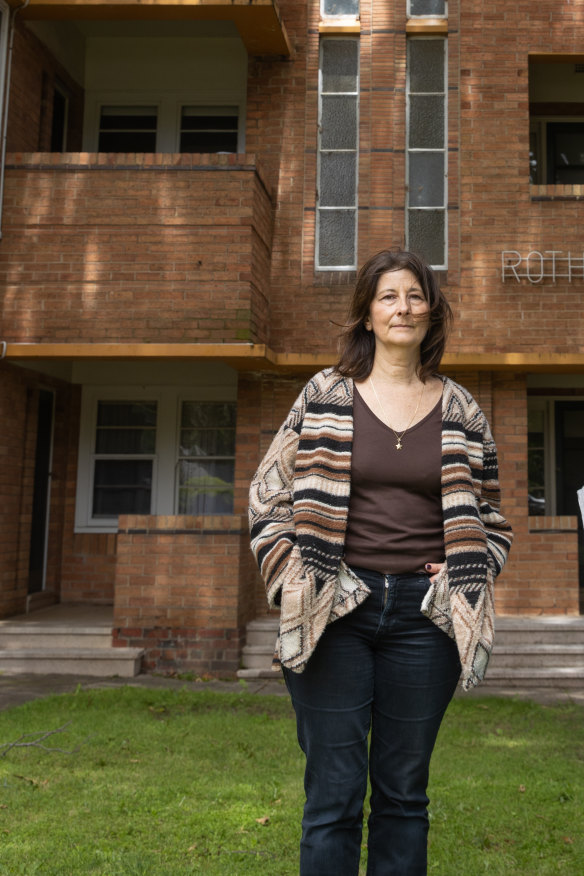
Boroondara Heritage Group’s Christina Branagan outside Camberwell’s Rotherwood block.Credit: Simon Schluter
The boom in luxury apartments is being propelled by a range of socioeconomic factors. Brian Seidler, executive director of the Master Builders Association of NSW, says they include cashed-up Boomers and Gen-Xers downsizing after offloading the family home, the unquenchable demand for greater floor space, and higher profit margins per square metre for developers. But the root cause, he says, is the cold, hard, high price of land in desired areas.
If the last apartment building boom led to today’s tsunami of building defects, you can’t help but suspect this new wave of developments, fast-forwarded because of the housing crisis, might make things worse. Beyond the most high-profile examples in Sydney of serious construction faults – the Opal Tower at Olympic Park, Mascot Towers, a block of loft-style apartments in Zetland, a four-tower development containing 900 apartments in Macquarie Park – are the stories that don’t make the media. Nearly four in 10 new apartment buildings in NSW have serious defects, costing an average $331,829 per building to fix, according to research by the Strata Community Association of NSW. In Victoria, it’s worse: up to 60 per cent of new apartments are riddled with construction flaws, from faulty foundations and water leaks through poorly waterproofed balconies and windows to flammable cladding, according to a new survey by Australian Apartment Advocacy (AAA). “Even penthouses fetching $1.5 million or more are affected by roof leaks and inappropriately applied waterproofing or membranes,” says Samantha Reece, founder and CEO of AAA, which represents 2.5 million apartment owners nationwide.
Shoddy workmanship has led to a surge in additional strata levies in both states. “We’ve seen apartment blocks with $9 million defect bills, where the developer has shut the ABN, and [the owners] have no protection,” says Reece. “People have been locked out of their apartments until the defects are fixed. The flow-on effect is that insurance companies won’t cover the building and banks won’t lend against it – it’s a nightmare. We’ve seen people take their lives over this stress.”
If there’s one person who predicted the current housing crisis with uncanny accuracy, it’s economist Cameron Murray, author of The Great Housing Hijack, published earlier this year. At the height of COVID-19 in 2020, he predicted a post-pandemic housing boom, for which he was roundly ridiculed. Indeed, in May that year, the Commonwealth Bank released a report predicting a fall in house prices of 32 per cent the following year. Instead, the unthinkable happened: Sydney house prices surged to their steepest annual increase in 2021, rising by an average of more than $400,000, before peaking in early 2022. “My favourite post was, ‘Where did Cameron get his economics degree? The back of a Cornflakes packet?’ ” he jokes.
‘High levels of immigration might have helped the economic recovery, but they increase demand for housing.’
Economist Cameron Murray
Murray had the last laugh: he bought a home mid-pandemic and its value soared by 40 per cent in 2021. A 41-year-old father of two, he tells me urban growth happens in a far more complicated way than the simplified NIMBY v YIMBY culture war. “The yes-in-my-backyard position is ‘unaffordable’ rents and home prices are all about housing supply, preferring the easy story that the fault lies with planning regulations and heritage controls.” He outlines a raft of reasons, including record high immigration after COVID-19, the construction industry grinding to a halt during the pandemic, soaring prices for materials, and disruptions in the supply chain, for today’s housing shortage. “High levels of immigration might have helped the economic recovery, but they increase demand for housing, which is why property speculators, landlords and YIMBYs love keeping those rates high.”
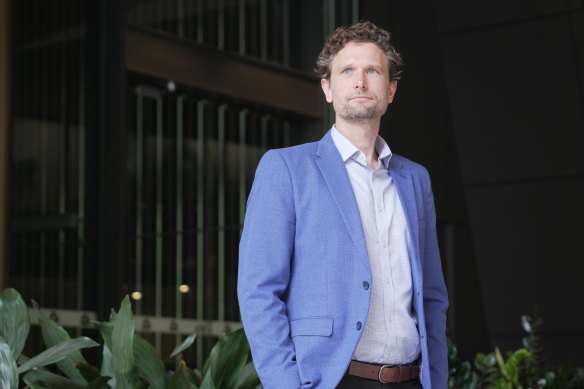
Economist Cameron Murray, who was initially criticised for predicting a post-pandemic housing price boom.
In my neighbouring suburb, tiny 160-hectare Erskineville, jammed between Newtown and Alexandria, the population ballooned from 6558 in 2006 to 9657 in 2021, thanks to a two-decade-long apartment-building boom across sites once occupied by abandoned factories. But the increase in supply hasn’t resulted in cheaper prices: the mean rental for a two-bedroom apartment in once-humble “Erko” is now $900 a week.
The number of empty homes is dictated more often than not by market forces, Murray believes, citing the example of the 2018 Commonwealth Games athletes’ village. At a time when the rental vacancy rate on the Gold Coast was 2.5 per cent, it took four years for the 1251 dwellings to be leased out. This wasn’t because of lack of demand, he notes, but because the managers opted for a carefully staged release so as not to flood the market and depress prices. Nor is the unoccupied-houses trend limited to Australia. Murray points to a 2022 article in Investigate Europe, which observed: “Europe has reached a point where there are too many people without houses and many homes without people.”
Empty houses, apartment-building defects caused by unfettered development: these aren’t typically mentioned by yes-in-my-backyard groups, which continually claim to be “grassroots” organisations. In Brisbane, YIMBY Qld co-founder Natalie Rayment, a town planner with 25 years’ experience, is the executive director of the Wolter Consulting Group, “providing planning … to government, development and infrastructure sector clients”, according to the company website. For her part, Rayment doesn’t see any conflict of interest with her “grassroots” YIMBY work. “As a registered planner in Queensland, I’m bound by the PIA code of conduct,” Rayment tells Good Weekend in an email. “I also regularly give evidence in court as an expert planning witness and so my professional conduct is held to high account. I strive for continuous improvement in our industry.”
Melissa Neighbour, one of Sydney YIMBY’s three founders, is the owner of Sky Planning, a town planning consultancy based in Balmain, which counts among its clients Rawson Homes and Hall & Hart Builders. “Melissa works closely with developers through all phases of the development process,” according to her company’s website, which lists among her specialties “planning proposals and re-zoning”. “We believe planners, architects and other professionals can bring valuable perspectives to the debate,” Neighbour tells Good Weekend in an email. “That’s why they are able to serve on NSW planning panels, and we adopt the same standards expected there: no property developers and recuse yourself where you have a conflict of interest.”
YIMBYs are on the same page as NIMBYs with one thing: wanting to curb urban sprawl on our city fringes. The great divide is over how to achieve it. “We need to make more efficient use of existing infrastructure by increasing densities in well-located areas close to high-frequency transit,” says Rayment, who has worked with the Property Council of Queensland on plans to build 14,000 high-density homes in Brisbane’s Woolloongabba, allowing developers to build towers up to 75 storeys.
The only factor likely to really shift the dial on affordability is a big boost in social housing.
Demand for affordable housing has now become pressing. Last month, in a move widely applauded on all sides of the debate, the Minns government announced it would build 400 apartments in central locations at reduced rents (by about 20 per cent) for Sydney’s essential workers, such as firefighters and nurses. It also promised an audit of surplus government land for affordable housing construction, identifying the Carriageworks precinct near Redfern station for 500 new dwellings, half of which would be affordable homes. But the only factor likely to really shift the dial on affordability is a big boost in social housing, which calculates rent based on income and household size.
The YIMBYs are right to suggest the Baby Boomers and Gen-Xers have been the luckiest generations in real estate history. High home ownership levels are a relatively recent phenomenon in Australia. At the turn of the 20th century, home ownership was under 40 per cent in metropolitan areas; by 1943, it had only risen to 43 per cent. It was only in the “golden age” of economic expansion – from the end of World War II to the mid-1960s – that home ownership soared, reaching a peak of 71 per cent in the early 1970s, not far from its current 66 per cent. Nor is this Australia’s first housing crisis: there was an even more severe housing shortage in the years after World War II, and intermittently throughout the 1800s: on his visit to Sydney in 1836, Charles Darwin referred to the “high rents and difficulty in procuring a house”.
In his recent Quarterly Essay, “The Great Divide: Australia’s Housing Mess and How to Fix It”, finance journalist Alan Kohler wrote that young Australians are paying more than twice the multiple of their income for a house than their parents – and their grandparents – did. “The places we call home and bring up our families in have been turned into speculative investment assets by the 50 years of government policy failure, financialisation and greed that resulted in 25 years of exploding house prices,” he writes.
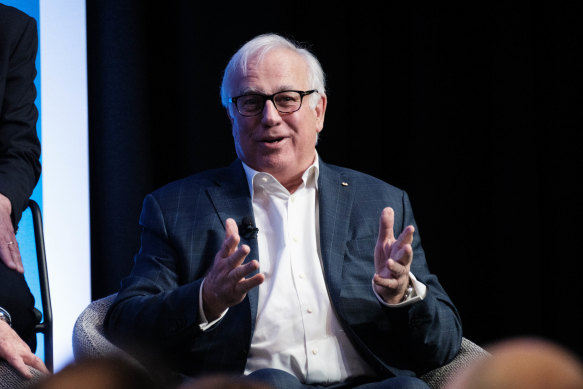
Finance journalist Alan Kohler: “The last Census revealed more than a million homes were empty on Census night.”Credit: Oscar Colman
Kohler says there should be more focus on the homes we already have – unoccupied or under-occupied – given the building industry is still lagging due to skills and supplies shortages. “There are 11 million houses in Australia for 27 million people,” he tells Good Weekend. “The last Census revealed more than a million homes were empty on Census night. It also showed that about one in three two-person households live in a four-bedroom house.” Given the time and cost required to build new homes, he asks, why not make better use of existing houses by creating tax incentives for renting out granny flats and dual accommodation?
But what of the relatively recent influx of international property investors – are they, too, increasing the number of empty houses and pumping up prices? In March, the federal government passed a bill doubling the penalties for foreign investors who leave their residential properties unoccupied. The fees hike applies to all foreign-owned dwellings bought after May 2017; for future purchases, there will be a six-fold increase in fees. According to the latest Australian Taxation Office figures, foreign investors appear to be returning to the Australian housing market with relish, often at the higher end, driving a 27 per cent increase in total transactions over the past year; Victoria is now the favoured address. Foreign investors still represent only five to 10 per cent of the total dwelling turnover in Australia, however.
‘It’s a myth that heritage protection locks up a property, shielding it from modernisation.’
Architect David Burdon
State governments are trying to do their bit, too. Decades of poor housing policy are being addressed, at least partly. In a determined effort to reduce land banking, in 2018 the Victorian government introduced a new vacant residential land tax in Melbourne’s inner and middle suburbs on properties left unoccupied for more than six months. Charged annually at one per cent of the value of the property, it will apply from January next year to owners of all vacant residential properties statewide, with an added one per cent tax levied on residential land left undeveloped for more than five years. Authorities recently found 177 empty apartments in just five buildings liable for the tax – it’s now targeting 13 more apartment towers. As yet, there are no plans to introduce a similar tax in NSW.
Perched on an elevated wedge of land on Sydney’s Observatory Hill, between the carmageddon of the Cahill Expressway and the glistening Crown Casino tower, is the National Trust of NSW, housed in one of Sydney’s oldest buildings. David Burdon, the National Trust Director of Conservation in NSW and a qualified architect, says he was worried earlier this year when the NSW government unveiled a plan to develop high-density apartments around railway stations. “It’s a well-intentioned idea, but the sites have to be carefully selected and designs need to respond to context,” says Burdon. A half-century ago, he reminds me, union activist Jack Mundey successfully battled to save The Rocks from the jaws of high-rise developers, while journalist Juanita Nielsen paid with her life to protect rows of Victorian and Federation filigree terraces on Victoria Street, Kings Cross, from the bulldozers. “We owe it to those conservationists, and for the future residents, to help protect the best parts of our heritage,” he says. “Once it’s gone, it’s gone.” (Sadly, Melbourne had no Jack Mundey to save Collins Street, once lauded as one of the grandest Victorian streetscapes in the world, much of it razed between the 1950s and 1970s for glass and steel towers.)
Heritage controls also came too late for central Sydney, once affectionately known as the “amber city” for its wealth of golden sandstone public buildings that were bulldozed in the 1950s, ’60s and ’70s. “It’s a myth that heritage protection locks up a property, shielding it from modernisation,” says Burdon. “The best way to protect heritage is to use it, and we can modernise our heritage homes, commercial and public buildings, to keep them functioning.”
A key argument of developers, of course, is that new buildings are more energy-efficient. “There’s an old adage that the greenest building is the one that’s already there,” counters Burdon, pointing to a United Nations estimate that 37 per cent of global emissions come from the construction industry. Studies show that in terms of greenhouse emissions, it’s almost always better to retrofit, with construction-related environmental impacts reduced by at least 50 per cent, even if it can often be more costly. “There are few incentives for developers to re-use or retrofit old buildings,” he sighs.
Ann Austin, head of sustainability at Lendlease Australia, responds that not all older buildings can be retrofitted to meet current codes, accessibility requirements or energy-efficiency standards. “Retro-fitting an existing building can have different benefits, such as reduction in waste and significant savings in upfront carbon emissions,” she says. But new buildings will be able to achieve better energy efficiency over the longer term, she adds.
Meanwhile, back in Melbourne, Shenley Croft is falling into worsening decay and the investigation into the arson attack continues. Many locals aren’t holding out hope for criminal charges, though: arson is one of the easiest crimes to commit and the hardest to prosecute. On the matter of what happens to the charred remains of the once-stately home, the local Boroondara Council has petitioned Victorian planning minister Sonya Kilkenny to enforce section 6B of the Planning and Environment Act, which prohibits development or profiting from land on which a heritage building has been neglected or unlawfully demolished. If enforced, it would be the first time Section 6B was used to stop an owner from demolishing a home, possibly forcing them to rebuild it.
Six months on, the council is still waiting on a response. So, too, are those who see it as something of a test case. “If Sonya Kilkenny does not enforce 6B, it will send a green-light message to any developer with a bent to destroy heritage-listed properties,” says Boroondara Heritage Group’s Christina Branagan. “All councils and locals are watching carefully what happens here.”
To read more from Good Weekend magazine, visit our page at The Sydney Morning Herald, The Age and Brisbane Times.
clarification
This story has been updated with a comment from Melissa Neighbour to make it clear she has been transparent about her town planning work for developers.